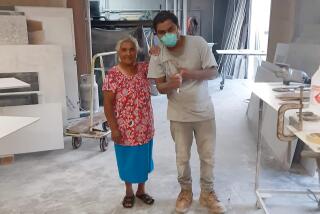Looking for cleaner kitchen surfaces

- Share via
KITCHEN counters are often the family catchall, where backpacks, bills and newspapers are dumped alongside the chicken thawing for dinner and the cereal bowls that didn’t fit into the dishwasher that morning.
But living beyond the field of vision on those countertops are some things you may be just as happy not to see: bacteria, viruses, mold and mildew -- a giant petri dish of microbes that could threaten your health. Many consumers are taking hygiene into account when shopping for new counters, which helps to explain why -- besides not being stylistically “in” anymore -- two old favorites, butcher block and ceramic tile, aren’t seen much in renovations and new designs anymore.
FOR THE RECORD:
Stone counters: A chart accompanying a Nov. 18 Real Estate section story about countertop options said marble, soapstone, basalt and Jerusalem stone, among others, are tough and impervious to most stains. Treated soapstone and basalt fit that description, but marble and Jerusalem stone are highly porous and need regular care to be kept stain-free.
“Everyone seems more concerned about health with all of the news reports about staph infections and the flu,” said Pam Bentz of Handcrafted Metal, an Austin, Texas, manufacturer of countertops and sinks. “The fact that one countertop can be kept cleaner is becoming a selling point to many people.”
In a study done earlier this year at the University of Arizona, researchers spread E. coli bacteria around various types of kitchen counters, gave the surfaces all a similar cleaning, then measured how many organisms were left alive. Only a small fraction of the E. coli were destroyed on the butcher block’s porous wood surface, while two-thirds on stainless-steel counters were killed.
Laminate countertops are the bestselling surfaces in the U.S. because they’re available in a wide range of designs and are the least expensive. They are sanitary and clean up nicely as long as the surface hasn’t been scratched or damaged.
Beyond laminate, designers say homeowners shopping for new materials for kitchen counters are increasingly turning to natural products such as stone, metals and even glass.
“The fact that these can also have hygienic properties is a bonus,” said Troy Adams of Troy Adams Design in West Hollywood.
Particularly popular is granite. Sales of granite countertops have steadily increased during the last decade, according to the stone industry’s Marble Institute.
“People love natural stone, and granite is a classic material,” said Jim Becker of All Pro Remodeling in Tustin. “If you want to see what it means to people, check out how many times ‘granite countertops’ are mentioned in real estate listings. They really add something to the home.”
Although noted for its durability and appearance, if left untreated, granite also can become porous and provide a home to microbes. There are several nontoxic, food-safe sealers on the market that can be used to fill in the microscopic holes and cracks where bacteria can live.
Grout can harbor germs
Enamel tiles may be nonporous, but germs can live in the grout between the tiles.
“Even if it’s been sealed,” Becker said, “over time the grout wears down, and then you’ve got to make sure it’s clean when you’re preparing food.”
No matter how well-armed you are with a scrub sponge, you’re not going to kill all of the germs on your tile counter.
But what if you’ve got a tile kitchen and aren’t in the market for a new countertop? One solution is to make sure your grout is sealed. Acrylic sealers are available for less than $10 that can be “painted” onto grout and will protect it from bacteria and staining -- just be sure to wipe off any sealer that gets on the tile.
Some newer grouts on the market, such as SpectraLock by Laticrete, don’t need a sealer. The makers add Microban, an antimicrobial chemical, to the mix to retard the growth of mold and mildew spores. Microban is also added to synthetic counters such as Silestone.
“Most people are careful about keeping their counters clean, and they’ll use cutting boards to protect the counter surface,” said Roberto Contreras Jr., chief executive of Cosentino North America, which manufactures Silestone. “But having Microban embedded in the material gives you another layer of protection, some peace of mind.”
Synthetic counters such as Corian and CaesarStone provide the natural-stone look but with a nonporous, scratch-resistant surface.
Another upscale surface, concrete, is a popular choice for its durability, but it also needs regular waxing or sealing to protect against stains and/or holes where bacteria can hide.
Countertops made of stainless steel or copper provide the biggest shield against microbes. Countertop manufacturer Bentz said these surfaces, traditionally used in restaurants and hospitals, are often installed in the homes of chefs and health professionals -- people in the know.
A high-quality stainless-steel countertop is not cheap.
“It’s a major investment, not unlike high-end appliances and custom cabinets,” Bentz said. But “if you use your kitchen frequently, it may be worth the cost.”
Ideally, metal counters are made and installed as one piece and glued onto a wood subsurface, eliminating the need for seams.
“Any time there’s a break in the metal and there’s a seam, you have a potential for problems,” Bentz said. Over time, moisture could seep down to the wood subsurface, encouraging the growth of mold.
New designs and technologies are enabling consumers to have patterns in their stainless counters if they want to avoid a “clinical” look to their kitchen. And the better stainless tops can last as long as the house.
What if they start to look shabby?
“It’s possible to refinish your stainless with a micro-grain surface,” Bentz explained, to look as though it’s been swirled with a paintbrush.
Copper countertops could be the choice for those interested in a “country” motif for their kitchens. Copper, which is generally 20% to 30% more expensive than stainless steel, has been found in some studies to have natural antibacterial properties. And unlike with stainless steel, “stains” and imperfections just make it look more stylish. Bentz employs a “patinor,” who burns and chemically ages copper for those who want that particular look.
And then there’s glass, which is made in thick sheets that have been tempered to resist cracking and chipping.
“There are lots of things you can do with glass,” said kitchen designer Adams, “and because it’s completely nonporous, it’s very sanitary.”
“Glass can be etched with acid, and you can embed color and designs between the layers,” said Doris Rocklin, marketing manager for ThinkGlass, a Toronto firm that creates glass countertops sold in North America. The etching is done on the underside of the glass, between the laminate pieces, so the top surface remains smooth.
The volcanic choice
Those looking for an “earthy” feel to their kitchens might consider Lavastone, produced by the French company Pyrolave. “It’s been sliced out of lava fields in slab form, then it’s given an oven-fired enamel surface,” Adams said. “It’s extremely durable, nonporous, scratch resistant, you name it.”
Overall, there are many choices if you’re in the market for hygienic countertops, but none of them is better than just being aware of the issue.
“It’s all very simple: No matter what surface you use, keep it clean,” said Tustin contractor Becker.
Make sure the cleaner you’re using is approved by the manufacturer of your countertop. And as a rule, stay away from abrasives and harsh chemicals, such as acids and ammonia. When cleaning, take a tip from professional janitors and let the cleaner sit a few minutes on the surface to let it soak in and loosen stains and debris before wiping it down with a clean cloth or sponge.
“If they can do that in good restaurants,” Becker asked, “why shouldn’t it be the standard at home?”
More to Read
Sign up for Essential California
The most important California stories and recommendations in your inbox every morning.
You may occasionally receive promotional content from the Los Angeles Times.






